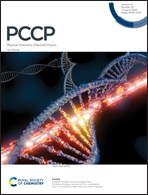Spin controlled surface chemistry: alkyl desorption from Si(100)-2×1 by nonadiabatic hydrogen elimination†
Abstract
An understanding of the role that spin states play in semiconductor surface chemical reactions is currently limited. Herein, we provide evidence of a nonadiabatic reaction involving a localized singlet to triplet thermal excitation of the Si(100) surface dimer dangling bond. By comparing the β-hydrogen elimination kinetics of ethyl adsorbates probed by thermal desorption experiments to electronic structure calculation results, we determined that a coverage-dependent change in mechanism occurs. At low coverage, a nonadiabatic, inter-dimer mechanism is dominant, while adiabatic mechanisms become dominant at higher coverage. Computational results indicate that the spin crossover is rapid near room temperature and the nonadiabatic path is accelerated by a barrier that is 40 kJ mol−1 less than the adiabatic path. Simulated thermal desorption reactions using nonadiabatic transition state theory (NA-TST) for the surface dimer intersystem crossing are in close agreement with experimental observations.

- This article is part of the themed collection: 2020 PCCP HOT Articles


 Please wait while we load your content...
Please wait while we load your content...